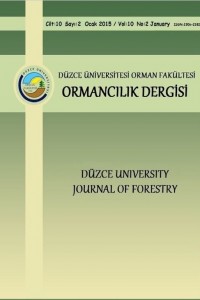Öz
Kaynakça
- Ateş E, Aztekin K. 2011. Parçacık ve fiber takviyeli polimer kompozitlerin yoğunluk ve basma dayanımı özellikleri, J. Fac. Eng. Arch. Gazi Univversity, Vol 26, No 2, 479-486,
- Bungay HR, Serafica GC. 2000. Production of Microbial Cellulose. US Patent Number: 6,071,727,
- Castro C, Zuluaga R, Álvarez C, Putaux JL, Gloria Caro G, Rojas OJ, Mondragon I, Ganán P. 2012. Bacterial cellulose produced by a new acid-resistant strain of Gluconacetobacter Genus, Carbohydrate Polymers, 89 (4): 1033-1037,
- Castro C, Zuluaga R, Putaux JL, Caroa G, Mondragon I, Ganán P, 2011. Structural characterization of bacterial cellulose produced by Gluconacetobacter swingsii sp. from Colombian agroindustrial wastes, Carbohydrate Polymers, Volume 84, Issue 1, 11 February, Pages 96–102,
- Cheng KC, Catchmark JM, Demirci A. 2009. Enhanced production of bacterial cellulose by using a biofilm reactor and its material property analysis, Journal of Biological Engineering, 3 (12), doi:10.1186/1754-1611-3-12,
- Fabio P. Gomes, Nuno H.C.S. Silva, Eliane Trovatti, Luisa S. Serafim, Maria F. Duarte, Armando J.D. Silvestre, Carlos Pascoal Neto , Carmen S.R. Freire. 2013. Production of bacterial cellulose by Gluconacetobacter sacchari using dry olive mill residue, Biomass and Bioenergy, 55, 205-211,
- Fu L, Zhang J, Yang G. 2013. Present status and applications of bacterial cellulose-based materials for skin tissue repair, Carbohydrate Polymers, 92: 1432– 1442,
- Gama M, Gatenholm P, Klemm D. 2013. Bacterial NanoCellulose A Sophisticated Multifunctional Material, CRC Press Taylor & Francis Group 6000 Broken Sound Parkway NW, Suite 300 Boca Raton, FL 33487-2742, International Standard Book Number-13: 978-1-4398-6992-5 (eBook - PDF),
- Goh WN, Rosma A, Kaur B, Fazilah A, Karim AA, Bhat R. 2012. Microstructure and physical properties of microbial cellulose produced during fermentation of black tea broth (Kombucha). II., International Food Research Journal 19(1): 153-158,
- Grande CJ, Torres FG, Gomez CM, Troncoso OP, Ferrer JC, Pastor JM. 2009. Development of self-assembled bacterial cellulose–
Öz
Some properties of bacterial cellulose (BC) Gluconacetobacter hansenii (Gossele et al.) after production were determined and compared with microcrystalline cellulose (MCC). The BC test specimens were prepared with standard Hestrin and Schramm (HS) medium. The obtained pellicels were evaluated after 14 days incubation. According to SEM analysis the diameter of the cellulose fibrils were measured between 20 nm and 75 nm. The water holding capacity was calculated 91 to 109 times higher than dry weigth. The cellulose yield of BC was between 0,81 g/l and 0,84 g/l. XRD, FTIR and TGA analysis were done and compared with MCC. The obtained results and comparison between the strain and MCC showed similiraty. According to the results the obtained BC can be used for food, cosmetic, medicine, paper and composites as raw material or filler.
Kaynakça
- Ateş E, Aztekin K. 2011. Parçacık ve fiber takviyeli polimer kompozitlerin yoğunluk ve basma dayanımı özellikleri, J. Fac. Eng. Arch. Gazi Univversity, Vol 26, No 2, 479-486,
- Bungay HR, Serafica GC. 2000. Production of Microbial Cellulose. US Patent Number: 6,071,727,
- Castro C, Zuluaga R, Álvarez C, Putaux JL, Gloria Caro G, Rojas OJ, Mondragon I, Ganán P. 2012. Bacterial cellulose produced by a new acid-resistant strain of Gluconacetobacter Genus, Carbohydrate Polymers, 89 (4): 1033-1037,
- Castro C, Zuluaga R, Putaux JL, Caroa G, Mondragon I, Ganán P, 2011. Structural characterization of bacterial cellulose produced by Gluconacetobacter swingsii sp. from Colombian agroindustrial wastes, Carbohydrate Polymers, Volume 84, Issue 1, 11 February, Pages 96–102,
- Cheng KC, Catchmark JM, Demirci A. 2009. Enhanced production of bacterial cellulose by using a biofilm reactor and its material property analysis, Journal of Biological Engineering, 3 (12), doi:10.1186/1754-1611-3-12,
- Fabio P. Gomes, Nuno H.C.S. Silva, Eliane Trovatti, Luisa S. Serafim, Maria F. Duarte, Armando J.D. Silvestre, Carlos Pascoal Neto , Carmen S.R. Freire. 2013. Production of bacterial cellulose by Gluconacetobacter sacchari using dry olive mill residue, Biomass and Bioenergy, 55, 205-211,
- Fu L, Zhang J, Yang G. 2013. Present status and applications of bacterial cellulose-based materials for skin tissue repair, Carbohydrate Polymers, 92: 1432– 1442,
- Gama M, Gatenholm P, Klemm D. 2013. Bacterial NanoCellulose A Sophisticated Multifunctional Material, CRC Press Taylor & Francis Group 6000 Broken Sound Parkway NW, Suite 300 Boca Raton, FL 33487-2742, International Standard Book Number-13: 978-1-4398-6992-5 (eBook - PDF),
- Goh WN, Rosma A, Kaur B, Fazilah A, Karim AA, Bhat R. 2012. Microstructure and physical properties of microbial cellulose produced during fermentation of black tea broth (Kombucha). II., International Food Research Journal 19(1): 153-158,
- Grande CJ, Torres FG, Gomez CM, Troncoso OP, Ferrer JC, Pastor JM. 2009. Development of self-assembled bacterial cellulose–
Ayrıntılar
| Bölüm | İç Anadolu’da Ağaçlandırma Çalışmaları |
|---|---|
| Yazarlar | |
| Yayımlanma Tarihi | 30 Ocak 2017 |
| Yayımlandığı Sayı | Yıl 2014 Cilt: 10 Sayı: 2 |
........


